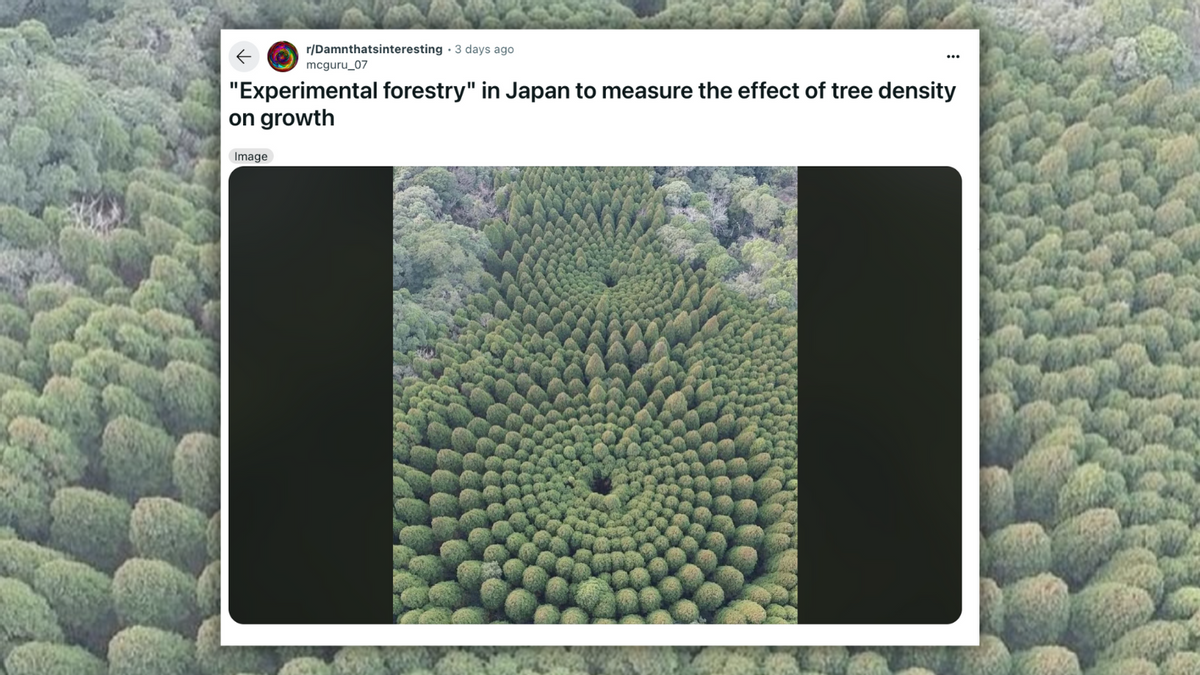In late September 2024, a photograph allegedly showing an experimental forestry project in Japan spread online. One Reddit post with the photo read: "'Experimental forestry' in Japan to measure the effect of tree density on growth."
The image was shared on various social media platforms, including Instagram, 9GAG, Facebook, Pinterest, and X (formerly Twitter). TinEye search results showed the image had been circulating online at least since 2019 and that it was available on Alarmy.com, a stock photo website, and on the official Facebook page of Japan's Forestry Agency.
Snopes determined the photograph in question, which is also accessible from The Associated Press' image archive, is authentic and accurately depicts a forest in Japan planted to study the impact of cedar tree spacing on growth. We have rated this claim as true.
The photo shows cedar trees arranged in two groups of concentric circles outside Nichinan, a city in Miyazaki Prefecture, Japan, on Jan 28, 2019. "The obisugi cedar trees were planted in a local forest to examine the growth and strength of the variety, which can be found throughout the city. The trees in the outer ring are approximately 20 meters tall, about five meters taller than those in the center," the Associated Press caption read.
The circular forest is also discoverable on Google Maps:
According to the website of the Ministry of Agriculture, Forestry and Fisheries of Japan, the experimental forestry project was initiated in 1973 with the aim of studying the effects of tree density on growth by planting cedar trees in ten-degree radial increments to create circular formations (we translated the paragraph below from Japanese, emphasis added):
Japanese cedar plantation (the Japanese cedar is at the top of the photo)
"Stand Density Test Forest (Mystery Circles)"
In the Minami Naka region of Miyazaki Prefecture, famous for Obi cedar, a unique type of timber called benko lumber has been produced for shipbuilding purposes through sparse planting of seedlings. However, due to a decline in demand for benko lumber, the region has shifted to general timber production, where trees are planted more densely than benko lumber production, in order to meet the demand for general building materials.
It was against this backdrop that the "stand density test forest" was established in 1973.
In this test forest, in order to switch from sparse planting to dense planting, the aim is to verify the effects of different planting densities on growth processes and changes in material quality, and to establish an efficient management system for Obi cedar. 36 cedar trees are planted at the intersections of 10 concentric circles of different radii, radially outward at 10° from the center of the circles, so that the density per hectare is set to be between 377 and 10,027 trees.For this reason, when this forest is viewed from above, the tree trunks spread out in concentric circles, which has led to the topic of discussion that they look like "mystery circles."
For further reading, in January 2015 we investigated whether a law in Japan makes it illegal for citizens of that country to be fat.

